
• HOME • IDEA • PLANTS • GALLERY • MODELS • BOOKS • ACTION • WEBLINKS • SOURCES • LAWS •
| CURRENT FEATURE | ||||
| 250 Sand : Replacing Turf and Hardscape | ||||
|
There are four prime enemies when islandscaping that are guaranteed to retard the sense of place on barrier islands. Concrete, asphalt, manufactured pavers, and lawns. The non plus ultra topographical surface feature of barrier islands (and much of mainland Florida) is white sand. For millenia the oldest barrier islands were covered with native vegetation while the newer ones were just a high sandbar of white sugarsand. The laid back toes-in-the-sand lifestyle of those who came early was soon to be civilized to death. Those who moved here after a long life in suburbia brought with them the infrastructure that had ordered the chaos of dense populations. In each town council election, new arrivals ran on a promise to save the island's charming, old Florida character they had discovered here. Then during their terms they unfailingly patted themselves on the back for authorizing ever more "improvements". And no administration's term ever ended without more concrete, more asphalt, and/or more pavers having been laid over the vanishing natural surface of the island they claimed to love. What wasn't covered with houses and hardscape was carpeted with St. Augustine sod or Tennesee river rock and decorated with plants and trees from tropical Asia, Africa, and Australia. Please, no more. No more concrete. No more asphalt. No more pavers or grass or rocks. Recapture the look and feel of the island. Take off your shoes. Put your toes back into the sand. |
||||
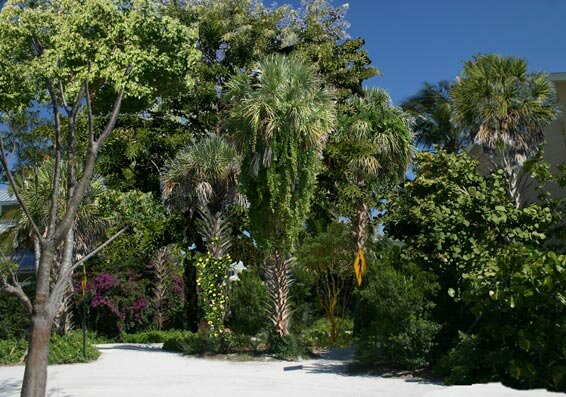 |
||||
|
In the design above, a pair of walks lead away from a drive aisle in the parking lot of the beachfront Sandbar Restaurant in Anna Maria that has now been landscaped with this maritime forest. All of the open areas are surfaced with four inches of 250 Sand, compacted. Under parts of the drive subject to heavy duty traffic are several thinner layers of 250 sandwiched with thin layers of medium washed shell. |
||||
| Major Benefits: | ||||
|
• The perpetual appearance of a natural place, not an artificial decoration. • Walking on it barefoot vs. on sharp shell, hard rocks, or hot pavement. • Stormwater is rapidly absorbed, dispersed, and percolated downward. • Minimal maintenance and easy repair. |
||||
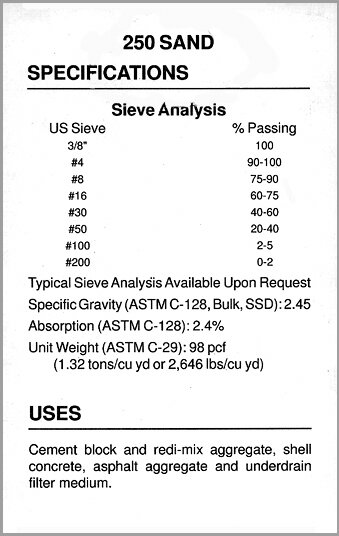 |
||||
|
250 sand is produced at the same mine that provide washed shell and beach compatible sand. It is a mixture of shell and sand of graded sizes. The larger components enable it to self compact under rain and foot or vehicle traffic. The finer sand components serve to keep the shell from hard panning, thus preserving its ability to percolate and disperse water down and sideways. It remains stable on 30º slopes unless subjected to gushing streams of water (from gutter downspouts, for instance) This photo is what 250 looks like installed. Just like the sand on a beach, it will be a light gray color when wet and will dry to a bright, clean white in the sun. |
||||
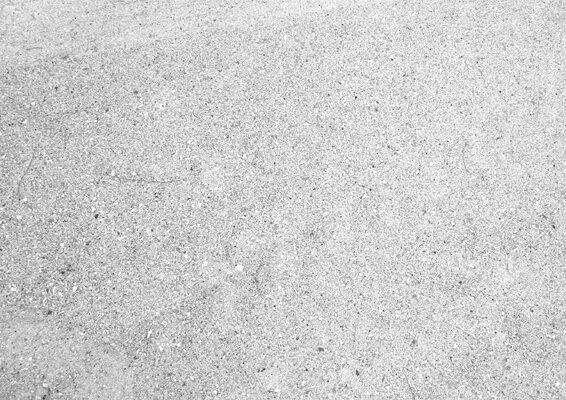 |
||||
|
Below is a landscape plan illustrating the use of 250 at an island residence. |
||||
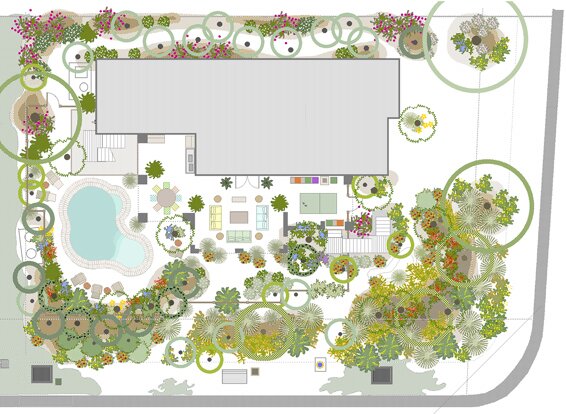 |
||||
|
• ENLARGE PLAN • In a forest landscape, leaves that fall on a 250 sand path are never a bother like they always are on pavement of any kind. Even when Oak trees are shedding their crown, it looks perfectly natural, so maintenance is never urgent. |
||||
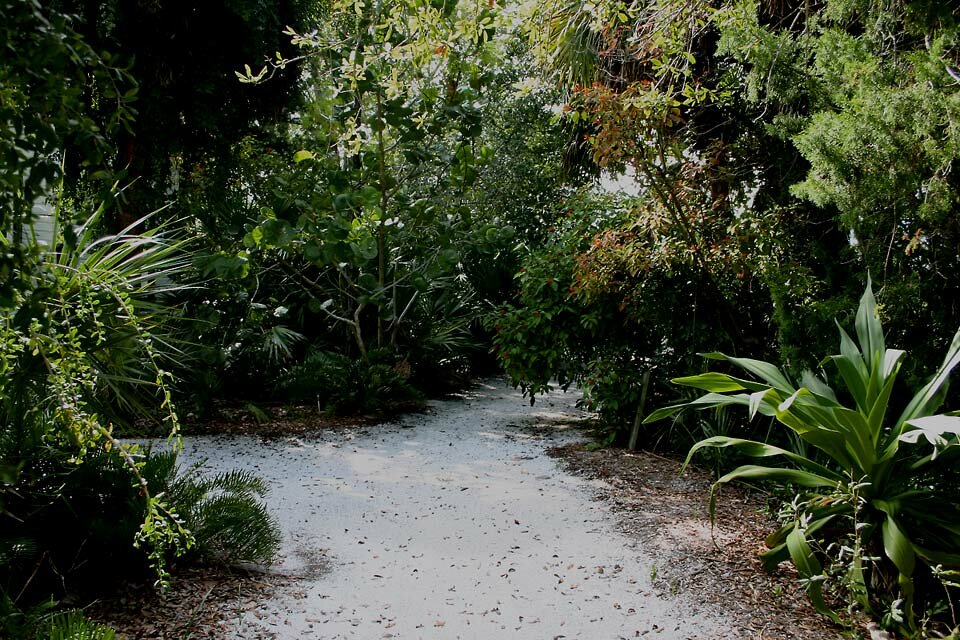  Purchasing 250 Sand Purchasing 250 Sand |
||||
|
The most efficient way to obtain 250 is by the truckload. Haulers with 18-21 ton capacity trucks will deliver it and charge only the hauling fee above the cost of the material at the mine. The fee will exceed the cost of the material and substantially affect the bottom line cost depending on the distance you are from the mine that produces it. The cost for 21 tons (18 cu yds) to Anna Maria is currently $575.There are also local sources who can deliver smaller quantities for about $35/cubic yard plus $55 delivery. |
||||
| Quantities and Cost | ||||
|
Calculating the quantities and estimating the cost in advance is an inexact science. While you estimate the quantity by the cubic yard, the sand is sold by the ton, and the number of cubic yds per ton differs when it is wet from when it is dry. Cost and quantity will also depend on how consistently the installers spread the sand in the desired thickness. • yds L x yds W x yds D (3"=.08yds, 4"=.11yds) = cu yds x 1.32 = tons • Partial loads are inefficient. Berm leftover sand as a repair reserve. |
||||
| Installation | ||||
|
• Distribute the 250 over the area with a bobcat. • Even out and spread into tight areas with shovels and claw rakes. • Smooth the top surface with a stiff bristled push broom. • Using a hose with spray-end or half-open shut off, wet the entire surface. • Compress with a compacter. • With repeated sprayings or a heavy rain you can skip the compacter. |
||||
| Maintenance | ||||
|
• Foot and light auto traffic areas are virtually maintenance free. • Repair dips in heavy traffic areas with a little shell topped with 250. • Traffic on tight curves requires scraping back displaced sand occasionally. • Restore to a perfect surface anytime with water spray and a pushbroom. • Blow or sweep leaves into adjacent planting beds. |
||||
| One More Thing | ||||
|
Proposing to someone that they substitute 250 Sand for all of their turf and hardscaping is the ultimate test of how much they understand and value the idea of living in a natural place in the real Florida. With little or no idea of what that means, and with barely any examples left or newly created to inspire them, few will leap at a chance to do it. The first kneejerk reaction will usually be, "but we'll be tracking sand into the house all the time!" "Look", I say, "just open the door, toss in a small handful of sand, and relax. When company comes, it will testify that you live a relaxed barefoot life on a beachy island, while they are living a regimented, leather-shoed life in an excessively neat and tidy urban sub-division. For the intransigent, there are several solutions. • 1) Put large natural fiber door mats outside entry doors and small thick orientals just inside. • 2) The classic beach cottage solution, a small container of water by each door, refreshed frequently to prevent mosquito larvae from hatching. • 3) The built-in solution of small wooden decks at each entry something to plop, plop, plop the sand off onto on the way in the house. That last one can add a lot to the transition from architecture to landscape. Look at one of the beautiful bottom-screwed tigerwood decks installed where sand meets the pooldeck and at each entry door of this island residence. |
||||
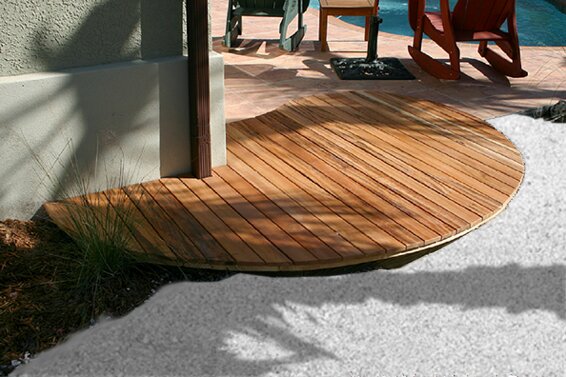 |
||||
| A Firm Surface | ||||
|
250 Sand will be re-compacted naturally with every rain, after which the surface is hard enough to be slightly uncomfortable for bare feet like shell is (but not as bad). Then, the top quarter-inch softens as it dries without losing its overall firmness. It is at all times suitable for bicycle and wheelchair access. In fact I was recently called on to install a 250 sand driveway for a gentleman whose wife was so crippled by arthritis and a debilitating pelvic condition that she could barely get across a few yards of their hard shell driveway to the door of a waiting car. Four inches of 250 laid over the shell and compacted solved that problem without having to pave over the large driveway and parking area of their beachfront home. Below are two paths firmed up to enhance access. This one is a scenic path along a mangrove shoreline ... |
||||
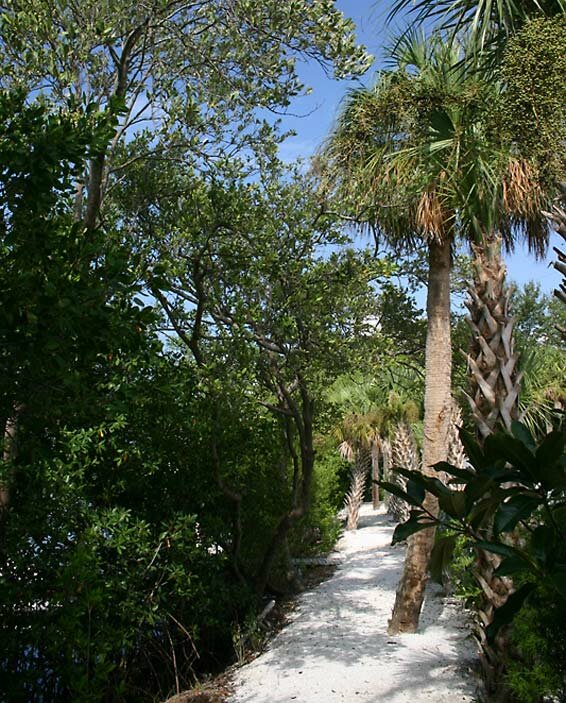
... and this is a long path to the beach across a dune field I recently restored. 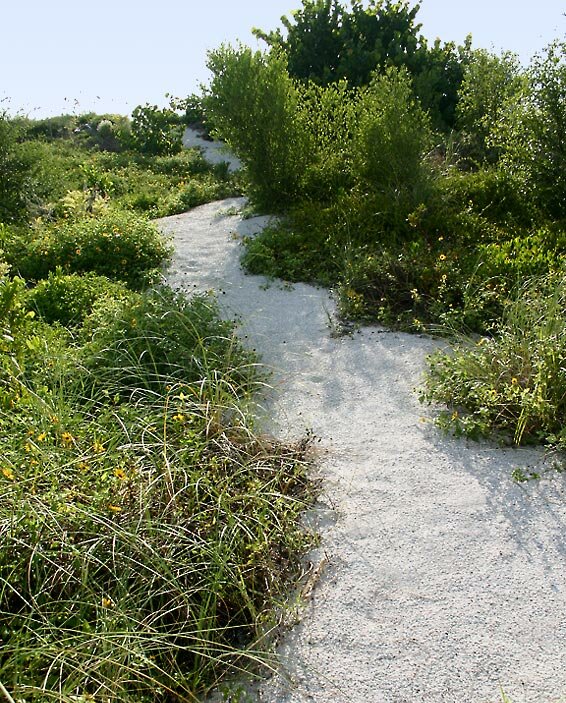
|
||||
| Finally ... | ||||
|
Note, in my 20-year transformation of the community playhouse courtyard on the grounds of the Anna Maria City Hall, the symbiosis between the 250 Sand and native vegetation with the theater's name the Island Players and its genuine Florida barrier island sense of place. |
||||
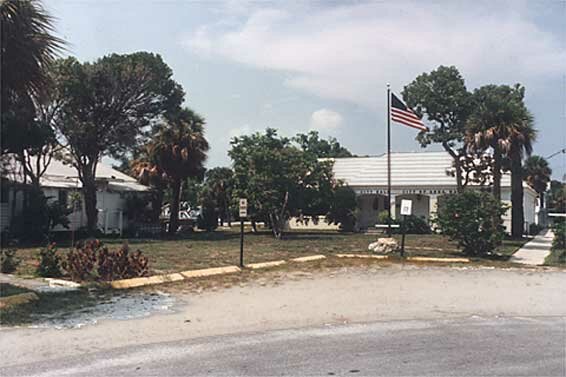 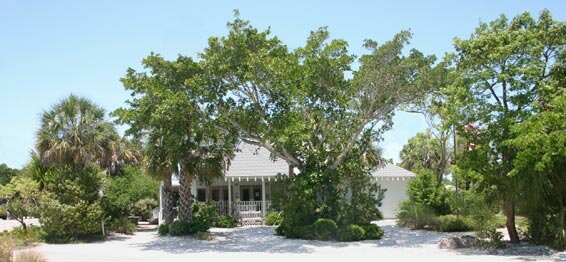
• ENLARGE PHOTO • |
||||
PERFECTING YOUR OWN ISLAND HABITAT--PLEASE CONTACT ME:
